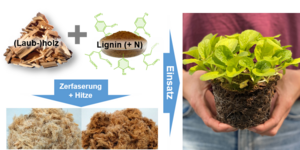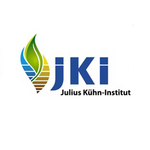Production and use of wood fibre as a peat substitute (HoFaTo)

Objective
Increasing the potential use of wood fibre in growing media optimised by increased nitrogen content and improved resistance to microbial degradation
Methodology
- Fibre production from different raw materials, testing of methods to reduce N immobilisation by enriching lignin and nitrogen onto the wood fibres
- Testing of the phytotoxic effect of the fibres and extracts by seedling tests
- Testing (pre-)optimised fibres in horticultural trials
- Standard-compliant life cycle assessments and determination of the GHG reduction contribution through the replacement of peat with wood fibre from indigenous raw and residual materials
Climate effect under consideration
Greenhouse gas saving potential of peat substitutes from wood
Publications
Coniglio R, Behrens D, Schütt F, Roesky N, Vogler U and Appelt, J. (2025): Exploring the potential of ammoxidation of lignins to enhance amide-nitrogen for wood-based peat alternatives and its impact on plant development. Holzforschung, 2025. https://doi.org/10.1515/hf-2024-0127
Coniglio R, Schütt F, Appelt J (2024): Challenges for the utiliza-tion of ammoxidized lignins and wood fibres as a peat substi-tute in horticultural substrates. Journal of Cleaner Production 475 (2024) 143737. doi.org/10.1016/j.jcle-pro.2024.143737
Contact persons
Thünen Institute, Institute of Wood Research
JKI, Institute for Plant Protection in Horticulture and Urban Green
JKI, Institute for Epidemiology and Pathogen Diagnostics




